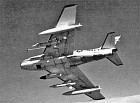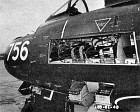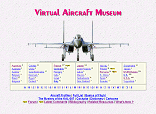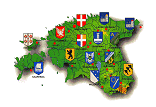Aircraft Profile #42. North American FJ Fury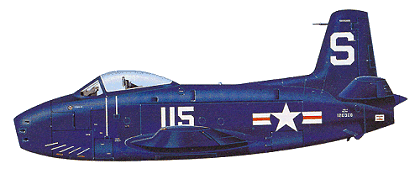 |
|
|
The evolution of naval aircraft has for more than fifty years been a particularly exacting exercise, a commitment rendered infinitely more difficult by the economics of relatively small production orders. Thus by force of circumstances it has been found more expedient to adapt an existing or projected land-based aircraft design for the task of deck operation, with the result that with so much paraphernalia appended the naval combat aircraft has commenced life with an inbred inferiority when compared with its dry-footed contemporaries. Only in the years following W.W.II have high performance combat aircraft been evolved with deck operation of first importance in the Operational Requirement; this has undoubtedly followed the trend of
One of the first examples of putting "the horse before the cart" was the North American FJ-Series of naval jet fighters. Of course the world recognises the excellence of the well-known F-86 Sabre, yet it is perhaps an obscure fact that the NA-140 (XP-86) design stemmed from the NA-134, designed to a U.S. Navy requirement of 1945. The North American NA-134 project designation covered the design and construction of three straight-winged fighter prototypes, ordered by the U.S. Navy on 1st January 1945. Developed from this was the NA-140 for an Air Force fighter, originally intended to have straight wings but, following intensive examination of sequestrated German
Deck landing speeds required by Navy fighters eliminated the consideration of a swept wing on the NA-134 design at that time and the project went ahead with straight wings, to become the North American XFJ-1. Unlike current fighters (e.g. P-59 and P-80) in service with or in production for the U.S.A.F., the new naval aircraft was designed around the axial flow General Electric J-35 which made possible the straight-through airflow from nose to tail without complications of wing-root or other lateral types of intakes. Thus while efforts continued to develop an efficient swept wing for the XP-86 and extend its
With 1730kg thrust from the J35-GE-2 engine, the first of the three prototypes (39053-39055) achieved a maximum speed of 872km/h at 4800m, a service ceiling of 14200m and an initial climb rate of 1400m/min. As a matter of passing interest these figures were extremely close to those of the British de Havilland Vampire I which had performed the world's first deck landing by a jet aircraft in late 1945 and which entered naval service during 1948. Flight trials on the three XFJ-1s continued for almost a
The FJ-1s, of which only 30 (130342-130371) came to be built - all at Los Angeles - were powered by Allison-built J35-A-4 engines; with 1815kg thrust, top speed was 880km/h at 3000m, and with two 750-litre wing-tip tanks supplementing the 2110 litres of internal fuel the ferry range was 2415km. Throughout 1948 VF-5A remained the only U.S. Navy squadron jet-equipped, but when this unit was
SWEPT WINGS Successful development of the swept wing on the � and Art C. Patch, and F-86As joined squadrons of the U.S.A.F. in 1948. By 1951, with events taking a more serious turn in Korea, the U.S. Navy had realised that swept-wing deck fighters were entirely feasible and, having studied a North American design proposal (NA-181) for a navalised F-86E, issued a letter contract on 10th February 1951 for development of prototypes. Commander Aurand, of VF-5 A fame, was appointed Navy Project Officer. Three prototypes were ordered from the Los Angeles plant. 133754 and 133755 (under NA-179) were essentially navalised F-86Es
� Hoover on 27th December 1951. 133756 carried the designation XFJ-2B, the B denoting a special armament modification for this machine carried four 20mm guns in place of the hitherto standard six 12.7mm machine guns. As would be expected, these radical swept-wing prototypes underwent intensive trials. The two XFJ-2s, with J47-GE-13 engines, were delivered to Patuxent River for Service trials in 1952, and armament trials were undertaken at Inyokern on 133756. Acceptance by the Navy of the prototypes was effected in June, July and December respectively, and carrier qualification trials were performed aboard U.S.S. Coral Sea in December 1952. Production of FJ-2s was undertaken at North
The FJ-2 Fury was, in effect, the U.S. Navy equivalent of the F-86F. Powered by a 2720kg thrust J47-GE-2 (Navy version of the J47-GE-27), the FJ-2 was equipped with folding wings and all-flying tail, and was armed with four 20mm. guns with 600 rounds, aimed by a Mark 16 Model 2 sight and AN/APG-30 radar. Naval equipment raised the take-off weight to 8530kg compared with 8080kg for the F-86F-10; top speed was 1088km/h
Although first production FJ-2s were delivered to the Navy in dark blue finish, most went to U.S. Marine Corps squadrons in natural metal finish. Korean War demands resulted in most of the Columbus effort being spent on Air Force F-86Fs, and FJ-2 production was slow during 1952, only five being completed during that year, and 25 by the end of 1953. First squadron to receive FJ-2s was Marine VMF-122 at Cherry Point, North Carolina, in January 1954, being followed five months later by VMF-235 aboard U.S.S. Hancock, a newly-modified carrier equipped with C-11 steam catapults. By 1955 FJ-2s equipped six Marine squadrons, three - VMF-122, 232 and
SAPPHIRE ENGINES Perhaps as much on account of this failure to secure prime Navy contracts for the FJ-2 as for the successful development of late-series F-86s, North American commenced on March 3rd 1952 the design of the FJ-3 Fury using the Wright J65-W-2 Sapphire engine of 3495kg thrust, built under licence from Armstrong-Siddeley Motors Ltd., in England. The first Sapphire-powered Fury was the
The FJ-3 succeeded where the FJ-2 had failed and altogether twelve Navy squadrons were thus equipped. By July 1954 twenty-four aircraft had been accepted and VC-3 and VF-173 performed the Fleet Introduction Programme at Patuxent River
VF-173 was the first U.S. Navy squadron to land on a carrier when it joined U.S.S. Bennington of the Atlantic Fleet on 8th May 1955. A Fury of VX-3, flown by Commander R. G. Dose on 22nd August 1955, was the first American aircraft to use the mirror landing system, a system that became standard throughout American carriers. Another
Furies had, during 1955, undergone a number of alterations; in July the U.S. Navy abandoned the all-blue finish in favour of dull grey upper and white under surfaces. Wing slats were replaced by extended leading edges in which were accommodated 563 litres of additional fuel. Underwing store points were increased from two to six making possible the carriage of 225kg or 450kg bombs, rocket packs or additional drop tanks. Sidewinder infra-red-seeking missiles, first fired at Inyokern in 1952, were fitted on the Fury from the 345th aircraft
By the end of FJ-3M production in August 1956, the U.S. Navy and Marines were operating twenty-three Fury squadrons, a total which remained until the end of that year although one of the Marine units, VMF-451, replaced its FJ-2s with a new, long-range Fury - the FJ-4 LONG RANGE ATTACK Design of the FJ-4 had commenced at Columbus in February 1953 under the direction of Frank Compton. In June that year the project was established under NA-208 for two prototypes and NA-209 for production, and by
The new design was identified fundamentally by a considerable increase in range, the fuel capacity being increased by 50%. To offset any loss of performance, the entire airframe was revised: a thinner wing of greater area and span, using integral skin/stringers and multi-spar construction, was milled from solid aluminium plate; mid-span wing control surfaces and high-lift flaps were incorporated, as were thinner tail surfaces - also with mid-span controls. A revised levered-suspension undercarriage was fitted to give an increased track of 1.5m. Entirely new fuselage contours with a dorsal spine from cockpit to fin probably provided the most
The first FJ-4, 139279, was flown by Richard Wenzell on 28th October 1954, and was powered by the Wright J65-W-4 of the FJ-3; production machines however had the 3500kg J65-W-16A. Classified as long-range attack fighters, the FJ-4 carried additional armour in the nose, space being provided by reduction of ammunition for the 20mm. guns. Four store wings could carry drop tanks, bombs and/or Sidewinders, but the "M" designation was not used. Performance included a top speed of 1095km/h at sea-level and 1015km/h at the tropopause, comparable with that of the Hawker Hunter 6, a British land-based contemporary. As already mentioned, the first FJ-4s to enter service joined Marine squadron VMF-451
The Fleet Introduction Programme of the FJ-4B was performed by VA-126 and VMA-223 on the Pacific Coast, particular emphasis being
In-flight refuelling was undertaken by Marine squadrons VMA-212 and 214 to enable them to complete the first trans-Pacific crossing by single-seat naval aircraft in October 1958. Late development of the FJ-4 continued until the end of
By the early nineteen-sixties Furies were being phased out of combat units and supplied to Reserve and shore units. All told, North American's Columbus plant delivered 1,112 aircraft to the Military between November 1952 and May 1958, perhaps a remarkable figure when it is remembered that Navy contracts were seldom regarded by manufacturers as prolific, and that during the same period Grumman, McDonnell, Chance-Vought (LTV) and Douglas were also building Navy fighters. F. K. Mason, 1965 |
 All the World's Rotorcraft
|














